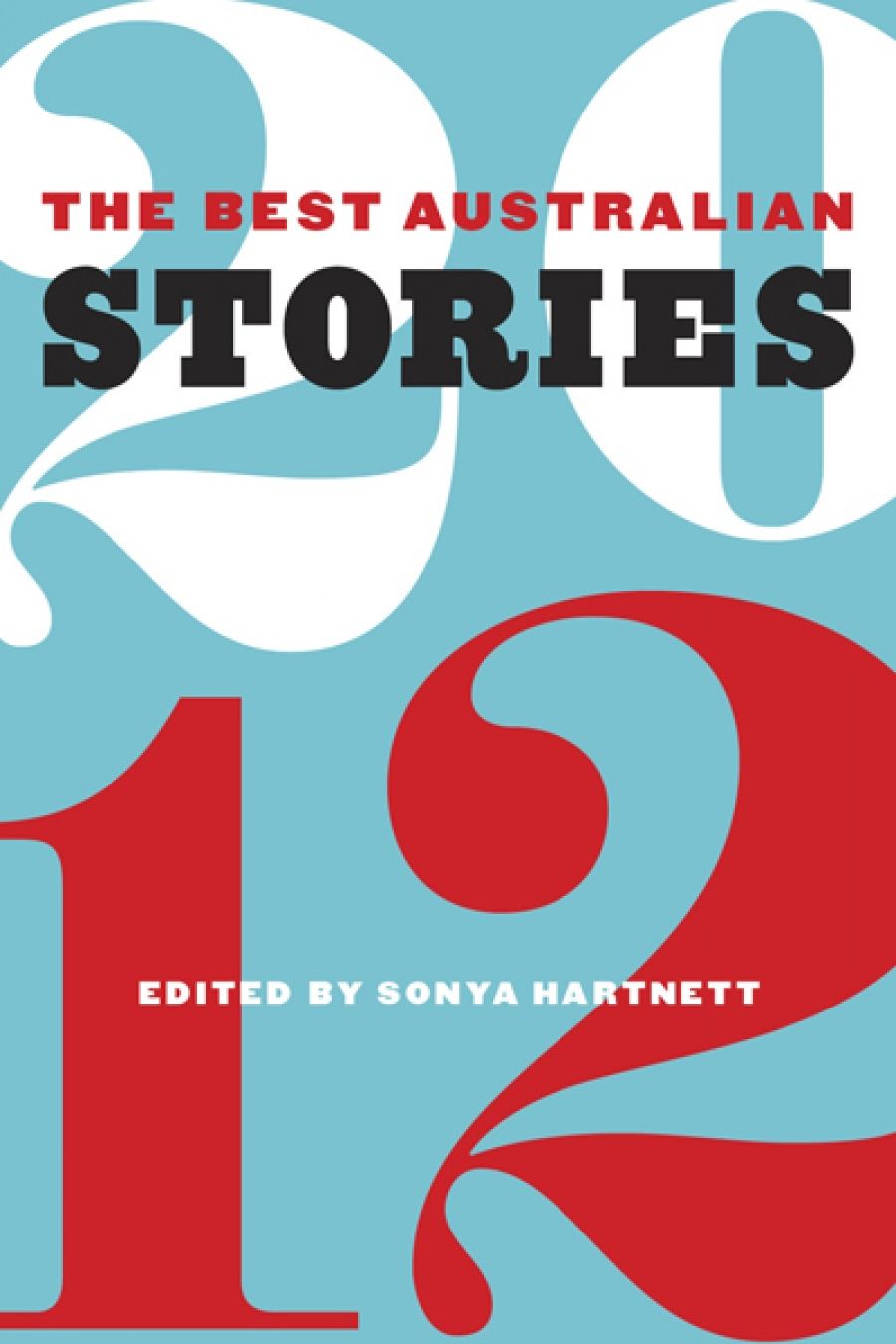
- Free Article: No
- Contents Category: Anthology
- Review Article: Yes
- Online Only: No
- Custom Highlight Text:
Sonya Hartnett’s début as editor of The Best Australian Stories is marked by a series of fictions about dysfunctional families, eccentrics, and misfits. The homeless, lonely, disenfranchised, intellectually disabled, sick, afflicted, even the dead, are featured alongside the privileged, rich, and famous in a macabre mardi gras. Readers familiar with Hartnett’s writing will recognise many of her own carnivalesque qualities.
- Book 1 Title: The Best Australian Stories 2012
- Book 1 Biblio: Black Inc., $29.99 pb, 369 pp, 9781863955805
Hartnett’s introduction is engrossing. Her selections are discussed with reference to an afternoon in her childhood when her sister read aloud Roald Dahl’s short story ‘The Man from the South’. Hartnett states, ‘Dahl, that dazzling devil, that dark trickster of a short story writer taught: short stories are stories … I have generally adhered to Dahl’s great law: that the purpose of a short story is to tell a story.’ But while she argues that her selectionsturn on their strong plots, it is actually the quirky and unexpected narrators and protagonists that bind this collection together. Many of the characters are appealingly creepy. Even characters that first seem reliable are, in the end, unhinged or slowly destroyed by the secrets they harbour.
For the most part, the previously published narratives outstrip their unpublished counterparts, suggesting that the editorial process of selection requires revision. The only exception is some established writers’ previously unpublished contributions. Indeed, Marion Halligan’s ‘A Willowy Woman’, about ‘a woman who flirts with priests’, is the wittiest story in the collection. The narrator’s envious sniping about Vanessa, the priest-flirter, is incredibly clever. However, Alex Miller’s ‘Ringroad’ is disappointingly more of a character dossier than a short story. Although the pompous, celibate narrator’s monologue has some affecting moments, the fragmentary nature of the piece is too conveniently explained with the note: ‘From an unfinished fragment of memoir found among the effects of the writer after his death.’
The best of these Best Australian Stories is Chris Womersley’s ‘A Lovely and Terrible Thing’. In this finely crafted narrative, the narrator, an employee of Ripley’s Believe It or Not, searches the country for world record-breakers, while simultaneously hoping for a miracle at home. He meets Angola, who has something to show him in the barn, a ‘lovely and terrible thing’. Womersley’s use of magic realism in his otherwise Steinbeckian narrative is fascinating. Sean Rabin’s ‘I Can Hear the Ice Singing’ also turns on a miracle when Jonas wakes up to find that his legs are stuck in the ice. The series of witness testimonies outlining Jonas’s life acts as a kind of fisherman’s myth. It is a cross between the fisher-king and the parable of the loaves and the fishes. Similarly, David Astle’s ‘Oxtales’ and Bram Presser’s ‘Crumbs’ are clever and original.
The Best Australian Stories 2012 can be loosely divided into stories that use black humour to deal with difficult situations, and uncanny pieces often set in remote places. The most original and witty stories are from this first category and include: James Bradley’s ‘The Inconvenient Dead’, which begins ‘A week after he killed himself Dane Johnson came to visit Toby at the service station’; Erin Gough’s ‘Benny Wins Powerball’, which is a modern take on ‘The Ant and the Grasshopper’; Alan Gould’s ‘The Raid on Australian Poetry’, which sends up the Australian literary scene; and Kate Simonian’s brave and moving piece ‘Scott’, where Brendan helps his intellectually delayed brother lose his virginity. Emma Schwarcz’s ‘Sidney’ also deals with a sensitive issue in quite a skilful way, but it becomes too obvious, too soon, why the narrator is unreliable. Similarly, Martin Lindsay’s ‘Someone Called Rob’, with ‘the fateful birthday card blunder’, is one of the funniest stories in its exploration of contemporary paranoia, but the ending is a let-down. Finally, the infernal anger and black humour in Zoe Norton Lodge’s repetitive ‘Yia Yia on Papou’ does not quite work; it tries too hard to be clever.
A second series of narratives concerns family secrets. Rebecca Harrison’s ‘Scissors’ has some engaging moments, but the protagonist’s monologue reads like a series of chapter summaries rather than a short story. However, the ‘bawling’ of the ‘big white calf’ caught in the fence wire is a haunting scene. Similarly, the dog, Bully, in Sarah Holland-Batt’s ‘So Far North’, steals every scene. As the narrative unfolds, the reader begins to breathe with and for the dog. Liam Davison’s ‘The Other Room’, Ashley Hay’s ‘The Crow’, and David Francis’s ‘Parts Unknown’ artfully explore the way in which secrets ultimately destroy families.
Overall, the collection is very conventional in form. Each story is at least four pages long and generally fewer than ten. Eric Yoshiaki Dando’s ‘Human Beans’ and Meredi Ortega’s ‘David Davis at Coldpigeon Dot Com’ are the only two stories that juxtapose prose with anything verging on the experimental. They are both exceedingly comic and appealing narratives. It is disappointing that there is no flash or micro-fiction and that many of the stories end on an ambiguous note. Ambiguity has replaced the twist as the literary author’s preferred conclusion. Eva Lomski’s ‘And Senseless Acts’ and Anthony Lynch’s ‘The Loveliest Night of the Year’ end more convincingly and interestingly.
The carnivalesque features of The Best Australian Stories 2012 make reading it a little like going to Coney Island: disturbing, darkly humorous, and haunting.


Comments powered by CComment